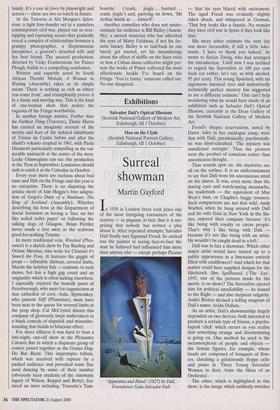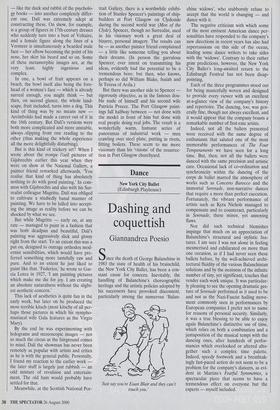Exhibitions
Salvador Dail's Optical Illusions (Scottish National Gallery of Modern Art, Edinburgh, till 1 October) Men on the Clyde (Scottish National Portrait Gallery, Edinburgh, till 1 October)
Surreal showman
Martin Gayford
In 1938 in London there took place one of the most intriguing encounters of the century — so piquant, in fact, that it is sur- prising that nobody has written a play about it. After repeated attempts, Salvador Dali finally met Sigmund Freud. So excited was the painter at seeing face-to-face the man he believed had influenced him more than anyone else — except perhaps Picasso Apparatus and Hand' (1927) by Dali, Foundation Gala-Salvador Dali — that his eyes blazed with excitement. The aged Freud was evidently slightly taken aback, and whispered in German, `That boy looks like a fanatic. No wonder they have civil war in Spain if they look like that.'
His more sober estimate the next day was more favourable, if still a little luke- warm. 'I have to thank you indeed,' he wrote to Stefan Zweig, who had arranged the introduction. 'Until now I was inclined to regard the Surrealists as 100 per cent fools (or rather, let's say, as with alcohol, 95 per cent). This young Spaniard, with his ingenuous fanatical eyes and undoubtedly technically perfect mastery has suggested to me a different estimate.' One can't help wondering what he would have made of an exhibition such as Salvador Dali's Optical Illusions, currently at the Dean Gallery of the Scottish National Gallery of Modern Art.
Freud's deeper reservations, noted by Dawn Ades in her catalogue essay, were that with Dali, paradoxically, psychoanaly- sis was short-circuited: 'The mystery was manifested outright.' Thus the pictures were the product of conscious rather than unconscious thought.
That sounds spot on: the mysteries are all on the surface. It is an understatement to say that Dali wore his unconscious mind on his sleeve. It was, even more than the staring eyes and watch-spring moustache, his trademark — the equivalent of Mae West's bust, or Chaplin's baggy trousers. Such comparisons are not that wild. Andy Warhol, when he hung around with Dali and his wife Gala in New York in the Six- ties, enjoyed their company because 'it's like being with royalty or circus people. That's why I like being with Dali because it's not like being with an artist. He wouldn't be caught dead in a loft.'
Dali was in fact a showman. Which other major artist would have turned up to a public appearance in a limousine entirely filled with cauliflowers? And which for that matter could have supplied designs for the Hitchcock film Spellbound (`The Eye', 1945, one of the pictures made for the movie, is on show)? The Surrealists ejected him for political unreliability — he leaned to the Right — and also incipient vulgarity. Andre Breton devised a telling anagram of Dali's name: Avida Dollars.
As an artist, Dali's showmanship largely depended on two devices, both intended to produce a certain type of frisson, a psycho- logical 'click' which occurs as you realise that something strange and disorientating is going on. One method he used is the metamorphosis of people and objects the female figures, for example, whose heads are composed of bouquets of flow- ers, clutching a gelatinously floppy cello and piano in `Three Young Surrealist Women in their Arms the Skins of an Orchestra'.
The other, which is highlighted in this show, is the image which suddenly switches — like the duck and rabbit of the psycholo- gy books — into another completely differ- ent one. Dali was extremely adept at constructing these. On show, for example, is a group of figures in 17th-century dresses who suddenly turn into a bust of Voltaire, and a female figure along the lines of a Vermeer is simultaneously a bearded male face — her elbow becoming the point of his nose, her skirt his beard and so on. Some of these metamorphic images are, at the very least, highly ingenious and complex.
In one, a bowl of fruit appears on a beach, the bowl itself also being the fore- head of a woman's face — which is already surreal enough, you might think — but then, on second glance, the whole land- scape, fruit included, turns into a dog. This kind of thing was by no means new — Arcimboldo had made a career out of it in the 16th century. But Dali's versions were both more complicated and more unstable, always . slipping from one reading to the other (thus making the whole experience all the more delightfully disturbing).
But is this kind of trickery art? When I wrote about the trompe l'oeil pictures of Gijsbrechts earlier this year when they were on show at the National Gallery, a painter friend remarked afterwards, 'You realise that kind of thing has absolutely nothing to do with good painting.' In com- mon with Gijsbrechts and also with his Sur- realist colleague Magritte, Dali was obliged to cultivate a studiedly banal manner of painting. We have to be lulled into accept- ing the image as reality before we can be shocked by what we see.
But while Magritte — early on, at any rate — managed to paint in a fashion that was both deadpan and beautiful, Dali's painting was aggressively slick and glossy right from the start. To an extent this was a put on, designed to outrage orthodox mod- ernist sensibilities, which would have pre- ferred something more tastefully raw and pure. And to an extent he just liked to paint like that. 'Federico,' he wrote to Gar- cia Lorca in 1927, 'I am painting pictures which make me die for joy. I am creating an absolute naturalness without the slight- est aesthetic concern.'
This lack of aesthetics is quite fun in the early work, but later on he produced the most terrible kitsch (most kitschy of all per- haps those pictures in which his nympho- maniacal wife Gala features as the Virgin Mary).
By the end he was experimenting with holograms and stereoscopic images — not so much the circus as the fairground comes to mind. Dali the showman has never been remotely as popular with artists and critics as he is with the general public. Personally, I found my reaction to the earlier work the later stuff is largely just rubbish — an odd mixture of revulsion and entertain- ment. The old ham would probably have settled for that.
Meanwhile, at the Scottish National Por- trait Gallery, there is a worthwhile exhibi- tion of Stanley Spencer's paintings of ship- builders at Port Glasgow on Clydeside during the second world war (Men of the Clyde). Spencer, though no Surrealist, used in his visionary work a great deal of bizarre, personal imagery. The results can be — as another painter friend complained — a little like someone telling you about their dreams. (In person the garrulous Spencer, ever intent on transmitting his ideas, evidently had the potential to be a tremendous bore; but then, who knows, perhaps so did William Blake, Isaiah and St Teresa of Avila.) But there was another side to Spencer rigorously objective, as in the famous dou- ble nude of himself and his second wife Patricia Preece. The Port Glasgow paint- ings fall halfway between — not done with the model in front of him but done with real people doing real jobs. The result is a wonderfully warm, humane series of panoramas of industrial work — men crawling over steel plate, putting in rivets, fitting boilers. These seem to me more visionary than his 'visions' of the resurrec- tion in Port Glasgow churchyard.



























































 Previous page
Previous page